*.·:·.✧ ✦ ✧.·:·.*"My thoughts are like stars, obscured by clouds of doubt yet sundering darkness..." *.·:·.✧ ✦ ✧.·:·.*➼ Youtube: https://www.youtube.com/channel/UCjflTgI3zJD7LdPjqK29k1g➼ TikTok: https://www.tiktok.com/@amaranthine_calamity➼ AO3: https://archiveofourown.org/users/frost_fire/pseuds/frost_fire➼ Wattpad: https://www.wattpad.com/user/blazing_blossom➼ MAL: https://myanimelist.net/profile/frostfire-san◣━━━━━━━━━━━◢
Don't wanna be here? Send us removal request.
Note
Why do you think "Raven in the Inner Place" is not as popular as "Apothecary Diaries"? I mean both have similar themes of mystery and cases, right? Both have strong, intelligent, and independent femMC with the supportive ML....
Oh yeah, you said that better to recommend you books than anime/manga, right?
Then, how about adding 'The Captive Prince' trilogy? Yes, they're 3 books but compared to TGCF or MDZS those 3 books are really short. Really, trust me...!
The couples' dynamics are so great! The mc (Damen) is such a sweetheart and you can't help but root and also love the ml (Laurent)....
Bonus, when you finished them, there are a lot of fanarts and fanfics of Damen/Laurent....🥰🤩😆
It's a slow burn story, angst with a happy ending, drama, political, that are so good...
Hope you'll love it...
Hi, thanks for sending in an ask! That's actually a question I ask myself all the time... I'm sure my household is tired of hearing my complaints about this issue so hopefully writing it out might give me some closure...
Before I start I'd just like to clarify some things...
I really like both series. In fact I started watching The Apothecary Diaries because I missed Raven of the Inner Palace... So in no way am I intending to hate on either series with this post...
While I'm currently reading the light novels of The Apothecary Diaries—and am on volume 8 presently—I haven't read any of the light novels of Raven Of The Inner Palace. Therefore I can only base my arguments off of the anime for the latter series, though I definitely plan on reading the novels at some point... That being said, I have included a spoiler for the finale of Raven Of The Inner Palace's light novel... However I have clearly marked it, so you can skip over it if need be...
From here on out I will be referring to both series by their respective Japanese titles as it's grammatically easier for me to use them in sentences.
───────────────────────
Why Kōkyū no Karasu isn't as popular as Kusuriya no Hitorigoto?
While a multitude of factors can contribute towards a disparity in popularity between two series, I believe the main factor at play in this case is the differing demographics of both series. Although Kusuriya no Hitorigoto is somewhat ambiguous in terms of demographic—considering the novel was initially aimed at women—it is largely considered to fall into the seinen bracket because its manga adaptation is serialized in a seinen magazine. Kōkyū no Karasu, on the other hand, is exclusively categorised under the josei demographic.


1.) Marketing and Investment
Throughout the history of the animanga industry, women have never been prioritised and accommodated for in the same manner that male audiences have. This is evidenced by the limited adaptations, merchandise and promotion shoujo and josei series receive relative to their shounen and seinen counterparts due to a perceived lesser profitability. Kusuriya no Hitorigoto has almost certainly benefited from being rebranded as a seinen. This change in demographic has undoubtedly resulted in the series receiving more investment resulting in better promotion and more adaptations—ultimately allowing it to reach a larger audience than Kōkyū no Karasu. The difference in production quality of both series’ anime can also be attributed to how adaptations of shounen and seinen series oftentimes have more polished adaptations—due to increased investment—which helps further bolster their popularity.


2.) Viewer Interest
Although not everyone is the same, most shoujo and josei fans enjoy a wide range of genres and demographics, whereas the vast majority of shounen and seinen fans only consume shounen and seinen animanga. The "rebranding" of Kusuriya no Hitorigoto into a seinen series has allowed it to resonate with a larger audience compared to Kōkyū no Karasu—thus resulting in the former series achieving higher sales and greater popularity.

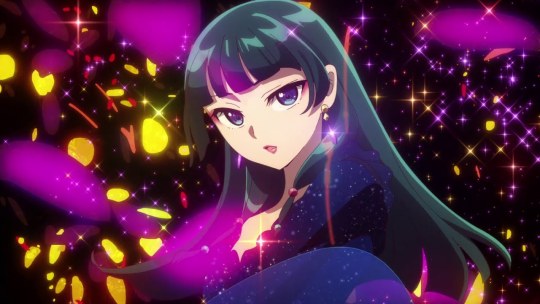
3.) The prioritization of romance in shoujo and josei demographics
Many of the executives in the animanga production industry mostly are men, who not only see greater economic potential in own demographics, but also have misguided assumptions about the demands and interests of the female audience. Furthermore production companies are more hesitant to invest in shoujo and josei adaptations—so when they do invest in these demographics, they tend to stick to what appears to be a safer option. Consequently shoujo and josei series with romance-focused narratives are pushed to the forefront as it is assumed that is what female audiences want. Shoujo and josei series that deviate from this pattern are often assumed to have a limited appeal and thus aren’t given as much investment and promotion. Whereas the shounen and seinen demographics are littered with series that prioritise genres other than romance. As a result, even though Kusuriya no Hitorigoto and Kōkyū no Karasu both emphasize topics and narratives beyond their romantic subplots—the former series likely encountered fewer obstacles in obtaining investment opportunities compared to the latter due to its shift in demographic. [Potential spoilers in the following paragraph!] Furthermore, the conclusion of the Kōkyū no Karasu’s light novel—which chose to solidify the relationship between its female and male leads as platonic rather than romantic—likely further limited the series’ potential for further investment opportunities due the prioritization of romance-driven narratives in series aimed at a female audience.
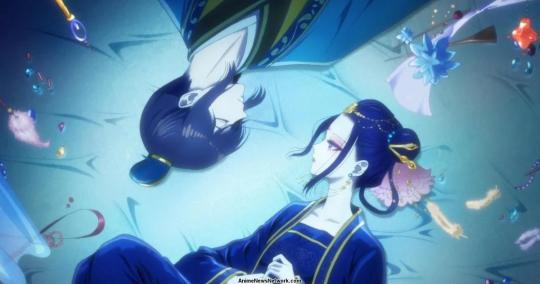

4.) Other points to consider:
-> Kusuriya no Hitorigoto's logic and science-based approach to solving mysteries likely appeals to a wider audience than Kōkyū no Karasu's mystical and fantastical elements. -> Kōkyū no Karasu expresses its character development and themes more subtly than Kusuriya no Hitorigoto does, potentially making it less appealing to broader audiences. -> The highly stylized visuals in Kōkyū no Karasu’s anime have resulted in the series having a more niche appeal than Kusuriya no Hitorigoto’s more straightforward presentation. -> Kōkyū no Karasu has always had to bear the brunt of comparison against Kusuriya no Hitorigoto, considering the former began publication in 2018 when the latter had already captured a substantial portion of the audience’s interest within the same niche. -> One of the primary critiques levelled at Kōkyū no Karasu’s anime is that it feels rushed and thus lacks depth and memorability, especially when juxtaposed with Kusuriya no Hitorigoto. However unlike the latter series, which had a 24-episode first season to meticulously develop its plot points and characters, Kōkyū no Karasu only had 13 episodes.
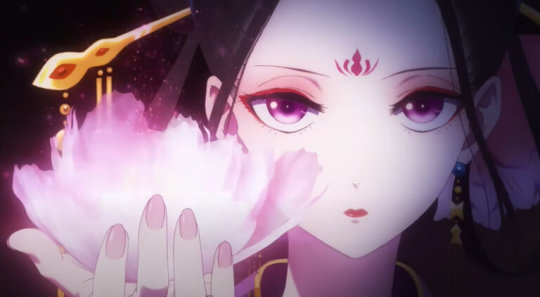

───────────────────────
Hopefully this meets your expectations... I'm a little nervous since I used a different writing style and tone than I usually do haha...
Btw thanks for the recommendations! Tbh, I wouldn't say I'm better at reading books then manga... It's just that my tbw and tbr lists are so long, it feels like I never get around to anything... So, I can't promise that I'll get to them soon. I've steadily been working on clearing my lists though, since it was my goal for this year. The polls I've been posting every now and then have really helped to keep me accountable—even if I go off book sometimes lol...
#frostfire-asks#koukyuu no karasu#kusuriya no hitorigoto#raven of the inner palace#the apothecary diaries#knh#shoujo animanga#animanga#josei anime#shoujosei#shoujo anime#anime discourse#anime discussions
10 notes
·
View notes
Text

TGCF Short Film Part 3 Promotional Artwork
#aaahhhhh!!! Xie Lian is wearing red!!!!!!!#also part 2 of the short film just released!!!!! Well I know what I'm doing today!!!!!#hualian#tgcf#tian guan ci fu#heaven official's blessing#mxtx#mxtx tgcf
160 notes
·
View notes
Note
Hi again, Frost...!
If you don't mind me asking, what are your top 5 (or top 10) favorite moments from any media that you love (can be books, anime/manga, tv series, movies, etc)?
Oh and do you mind if I ask you again? See, I really love your post about your "Top 15 fav female characters" (and all your other posts are lovely and amazing). So, can I ask what flowers that remind you of their characters? Please pick at least 3 characters (I know that you've already done Jiang Yanli and Tohru, so I'm curious about the others).
Thanks if you want to answer. Sorry if I ask too much....Feel free to answer whenever you have the time 😆😁
Hi again, thanks for sending in another ask!
───────────────────────
A.) My Top 10 Favourite Moments in Anime/Manga/Donghua
To be honest, making this list was quite difficult... My indecisiveness and tendency to overthink are completely to blame for this, haha.
At first, I wasn't quite sure how to go about setting a tone for this list and found myself contemplating whether to go for angsty moments, heart-warming moments, nostalgic moments or comedic moments. I was also thinking too much about what counted as a moment.
In the end, I mostly settled on impactful moments, which I felt had a blend of everything. I also decided to only allow myself one entry per series, otherwise I fear this list might've solely been filled with only 1-3 series...
⚠️Warning: Post-anime spoilers ahead for TGCF & Akatsuki no Yona⚠️











-----------------------------------------
B.) Character Hanakotoba Analysis x 3
I'm glad you enjoyed my top 15 favourite female characters post. I know a few people have been asking for the male counterpart, and I'm glad to say that I've finally started working on it. Although as of now I've only gotten a preliminary list and haven't at all gotten started on the writing or formatting yet...
Anyways, to get back on topic, I hope you don't mind that I've decided to choose the easier option of picking characters who have canonical flower associations that I haven't covered yet.
1.) Yona - Peony (Paeonia sp.)

While flowers are often featured in official artwork of Akatsuki no Yona, there doesn't seem to be very consistent associations with the series' characters. That being said, it does seem that Yona is canonically associated with peonies. These flowers were featured alongside Yona on the cover of volume 1 as well as in three of the anime's theme songs—namely, OP1, OP2 and ED2. Peonies are also the motif patterned on her robes in episode 1 and on the hairpin, Suwon gifts her. In Japanese hanakotoba, peonies symbolise shyness, humility, wealth and regalness. The flower's profound appearance, notably its multitudes of large petals that are thin and silk-like, is where the peony’s symbolism of wealth and regalness originated. In Western floriography, peonies represent bashfulness, compassion, bravery, beauty, loyalty, good luck, prosperity, honour and romance. In China, peonies are venerated as the "king of flowers", the "most beautiful flowers" and the "flowers of riches and honour". In accordance with this, they symbolise prosperity, honour, wealth and beauty, love and happiness.
2.) Misaki Ayuzawa - Star-of-Bethlehem (Ornithogalum sp.) & Strawberry Flowers (Strawberry Fragaria × ananassa)


I strongly associate Misaki with Star-of-Bethlehem flowers, as they were featured alongside her in the anime's opening theme song, and strawberry flowers—which were featured alongside her on the cover of volume 15. In Japanese hanakotoba, Star-of-Bethlehem flowers are associated with purity, innocence and talent. In Western floriography, these flowers represent purity, happiness, honesty, innocence, forgiveness and hope. Regarding relationships, Star-of-Bethlehem flowers represent acceptance and sincerity. In Japanese hanakotoba, strawberry flowers are associated with love, respect, foresight and a happy family. They are also said to symbolise the phrase "you make me happy". Furthermore, they are highly symbolic of youth, spring and new beginnings. In Western floriography, strawberry flowers symbolise esteem, love, affection and sweetness. They can also represent perfection, purity, innocence and reconciliation. Strawberries are also associated with femininity and beauty.
3.) Tsukuyo - Maple (Acer palmatum)

I can't help but associate Tsukuyo with maple leaves, considering that they are featured on her signature outfit. In Japanese hanakotoba, maple trees symbolise reservedness, precious memories and beautiful changes. They are also associated with endurance, passion, persistence, regality and resilience. Maple leaves can also represent the passing of the seasons, the changing nature of life, as well as the beauty and fragility of life. In Japanese culture, the maple tree's five-lobed leaf is a representation of wealth and good fortune. In Western floriography, maple trees are associated with peace, serenity, reservedness, unity, humility, strength, endurance, balance and wisdom as well as seasonal change and new beginnings. The maple tree is also considered a symbol of romance, considering its vivid, crimson autumnal leaves are associated with the intensity of love, while its sturdy roots represent the deep bond between two individuals. Furthermore, the tree's ability to endure adverse weather represents the tenacity and endurance required in romantic partnerships.
───────────────────────
#frostfire-asks#my top 10 anime/manga/donghua moments#noragami#given#mdzs#yona of the dawn#akatsuki no yona#fruits basket#fruits basket 2019#the apothecary diaries#kusuriya no hitorigoto#gintama#bleach anime#bnha#tgcf#anime hanakotoba#hanakotoba#anime floriography#misaki ayuzawa#ayuzawa misaki#kaichou wa maid sama#maid sama#tsukuyo gintama#gintama tsukuyo#bakudeku#ichiruki
8 notes
·
View notes
Note
Hanakotoba ask, here...
I know you never follow this series, so I know I can ask your objective opinion.
Can I ask what does they mean with those flowers in the arts?
https://twitter.com/MangaReporter/status/1865346278709694968?t=Y00tps_J4bmjU0VkFzr0Kw&s=19
https://twitter.com/fr1mm4l/status/1485334131987083268?t=OYUL2nJCOwBGBpdvlFa0ow&s=19
https://twitter.com/cielpilled/status/1902067887860515289?t=0C_8YmJQbYDKhQPg5RPBDA&s=19
Hi... Admittedly it's pretty difficult for me to do an analysis on a series I haven't seen since flowers have many different meanings across different cultures. Normally I'd only list the applicable symbolism but in this case I wouldn't know what was relevant...
While I focus on Japanese flower symbolism (hanakotoba), I also try to include additional symbolism relevant to the series' setting and origin—which is why I include Chinese flower symbolism for any donghua and danmei series I cover. While I try to do a general summary of Western flower symbolism, I imagine that any flowers featured in Black Butler would be based on Victorian floriography—not hanakotoba or modern floriography—which I'm honestly not particularly knowledgeable on.
That being said I honestly was willing to attempt an objective analysis but while researching which flowers were featured in the manga panels you sent, I found a blog on Tumblr that has done multiple posts on flower symbolism in Black Butler. Their username is @thedarkestcrow .
While I'm incredibly sorry if I've disappointed you, I think they've done a better job than I could have—given that they're very passionate about the series.

P.S. I hope this doesn't discourage people from asking me hanakotoba-related questions, because I'm always eager to cover series I've seen—and there are a few of those that haven't been covered yet. In fact I'm going to be working on a new hanakotoba post for a new series soon.
0 notes
Note
So BKDK is my first m/m ship ever. Yeah, until then, I always ship m/f ones and saw the same sex ones as just platonic (sorry I don't mean anything negative or being homophobic, it's just the way I was at that time).
Can I tell you something? When I first follow BNHA with my brother (about 8 years ago), I ship Bakugou with Uraraka (I know! It's random right?). My brother who dislike shipping, ships no one and said, "The endgame must be Midoriya with Uraraka. And there will be moments when they'll got closer just like Naruto and Hinata" (yes both of us are also Naruto fans)....
But as we enjoy the series over the years, I can't help but saw how special it is the bond between Izuku and Katsuki. Even my brother and I agree that, "Because of these canon moments. It's very clear that Katsuki have the role kinda like the love interests of the mc. Heck, the pining is so clear! Those BKDK shippers are really onto something." 🤩🤣
And that is why, I became BKDK shipper since 2022. My brother is not a shipper but an ally. So, you can imagine how shock we were when we read the epilogue! So agree with your post about the ending.
I found you because of your Hanakotoba of various anime/donghua. Thanks for sharing those beautiful posts. I never knew how important the meaning of the flowers. I also surprised when reading the posts about Fruits Basket, Gintama and Apothecary Diaries (these three have become my all time fav ever)....🥰😊😆
My friend asked me, how come I ship BakuDeku and not NaruSasu shipper? Honestly, I'm confused on how to answer that myself. Until I found your answer to why you love Naruto and Sasuke's dynamics but not shipping them. That's exactly what I feel, too.
It's also hard for me to start shipping them or seeing their bond as romantic.
I said that, but I'm not a fan of Naruto/Hinata or Sasuke/Sakura. I can't really explain (sorry cause I'm bad at explaining). But I just don't feel anything for the canon main ships.
Sorry for my rambling, feel free to skip the above because below are my questions for you.
1. What I want to ask, are, what made you love these ships? Why are they're special to you? For : BakuDeku, MinaKushi, ShikaTema?
2. If you were asked, what flowers that remind you of Bakugou and Midoriya, what would they be?
Note.
The last two are the only canon ships that I love from Naruto. For non canon, I ships Naruto/Sakura, Kakashi/Sakura (can you tell, how much I love Sakura? This is why I dislike how Sasuke treat her throughout the story), and Kiba/Hinata. Sorry for being random.
If you love the main canon ships, I hope you don't mind with what I said. Please, do know that I don't mean to bash any ships. They're all wonderful in their own way...
Hi! Thanks for sending in an ask... I'm so sorry that it's taken me this long to complete it.
I don't know if I've mentioned this before, but my first m/m ship was BakuDeku as well haha... So, I really relate to what you're saying... You're so correct about Katsuki filling many aspects of the role associated with the main heroine/love interest. I'm just glad that the new special chapter relieved most of my dissatisfaction with the epilogue and helped to restore the confidence of many bakudeku shippers... Horikoshi essentially said that we should imagine things the way we want, and I'm going to take that to heart. No ships were made canon for Izuku or Katsuki, so we're all free to envision the ending that we all wish for... And that's the best outcome we could've gotten after the epilogue...


Wow! A fan of Fruits Basket, Gintama and Kusuriya no Hitorigoto?! You have immaculate taste; those three series are all in my top 10! I'm glad you enjoyed my hanakotoba posts... I put a lot of work into them, so it always makes me happy when I see others appreciating them. Sadly, I can't do them as often as I want since there isn't always material...


Honestly, I've been evaluating my feelings on this SasuNaru/NaruSasu a lot lately since it's come up in asks a lot lately... Even my tiktok fyp is filled with the "I can't defend Naruto/Sasuke anymore" type posts... The more I see clips of scenes of them, the more my heart wavers a little. So, at this point, I don't quite know whether I can only see them as a platonic duo or whether I've gradually come to ship them and am just in denial... I get why people aren't fond of NaruHina or SasuSaku... I've been a Naruto fan for practically half of my life at this point, so my feelings have shifted a lot over time as well... To put things into perspective, when I first started watching Naruto, my older brother lied to me and told me that NaruSaku was canon... Ten-year-old me, who wasn't yet aware of the concept of shipping and fandoms, was not at all happy about that lol... But I was gullible and took him at face value, so I never allowed myself to formulate my own opinions about shipping for the main trio to avoid the inevitable disappointment. This is why I gradually became much more focused on side couples like NejiTen and ShikaTema even though practically everyone else was concentrated on the four-sided battle between NaruHina, NaruSaku, SasuSaku and SasuNaru. So, when NaruHina and SasuSaku became canon, I was surprised but decided to just roll with it and tried being optimistic about things... Though admittedly I grew fond of NaruHina primarily because of The Last Movie but was never as big of a fan of SasuSaku. Over time as I watched more anime and have grown to realise that the intentional romance in the Naruto series for the most part isn't nearly as decent as I once thought it was... Consequently, I've come to like NaruHina, and by extension SasuSaku, less and less—which is why neither pairing is in my top 30 anymore.


───────────────────────
Anyways, I feel like I've already rambled too much and have yet to answer your actual questions...
[1.) What I want to ask, are, what made you love these ships? Why are they're special to you? For : BakuDeku, MinaKushi, ShikaTema?]
-> 1.1. BakuDeku
I honestly could write an entire paper about the intricacies of their dynamic, as well as how consistent and central their development is throughout the series... However, there are many posts on this topic made by others far more eloquent with words than I am—so, I'll mostly focus on why I'm infatuated with this ship. As you know, BakuDeku is currently my second favourite ship, having formerly been my favourite for a considerable period. Although part of me was always drawn to their intriguingly complex dynamic, I only fully came around to the idea of them in a romantic context while watching season 3. Part of this shift can be attributed to my dissatisfaction with envisioning Uraraka as Izuku's love interest, given that Katsuki was the one who consistently fulfilled most of the key aspects of the role associated with the main heroine/love interest in shounen manga—a situation that especially reminded me of what happened with IchiRuki at the end of Bleach. My favourite aspect of their dynamic is undoubtedly its focus on emotional depth and growth, in addition to their inherent natural chemistry. Throughout their turbulent relationship, Katsuki and Izuku have constantly gravitated towards one another. Katsuki has only disclosed his innermost insecurities to Izuku, while the latter has always reached out to Katsuki during his lowest points. In a similar vein, it is constantly noted that Katsuki is the closest person to Izuku and understands him best, which enables him to get through to Izuku during the latter's lowest points. Throughout the series, it is often stated that Katsuki and Izuku are two sides of the same coin—that their seemingly opposed concepts of heroism are incomplete without the other. Only by learning from one another will they account for the flaws in their ideals and effectively embody the hero they both revere. In this sense, despite their differences, they do not contradict one another but instead accentuate each other's strengths while compensating for each other's respective weaknesses. Another aspect of their dynamic I adore is their tendency to mirror each other, whether intentionally or inadvertently. For example, in chapter 285 (Katsuki Bakugou: Rising), Katsuki's body moves on its own to defend Izuku, putting himself in danger, exactly as Izuku did in chapter 1. Another reference to this is found in chapter 119 (Deku vs. Kacchan Part 2), where Izuku admits to himself that at times he can't help but emulate Katsuki when he finds himself yearning for victory.


-> 1.2) MinaKushi
Although many Naruto fans only regard MinaKushi as being the protagonist's parents, it is probably the best canonical ship in the Naruto series in terms of writing—which is why they're my favourite canonical ship within the series. While Minato is an incredibly popular and relevant character, Kushina is oftentimes overlooked—even though Minato and Kushina's narrative roles, character designs, and names/titles are greatly intertwined with each other. While this pairing incorporates a few classic tropes, these tropes are implemented into their dynamic in a way that enhances their richness and strengthens their foundation. The way the Red String of Fate trope was incorporated into their narrative is probably my favourite aspect of this pairing. Their presence in the series remains palpable in the way their son embodies their shared ideals. This adds to their richness, helping to make their narrative arc feel concise and fulfilling despite not getting a lot of screen time. From a personal standpoint, their duality in terms of tone is deeply satisfying. Although their relationship and narrative role involve many serious themes, their dynamic has a humorous element created by their dynamic personalities. While their relationship was unquestionably fulfilling and secure, the tragedy of their early deaths imparts an element of angst and complexity.


-> 1.3) ShikaTema
Aside from NejiTen, ShikaTema was the only other pairing that I supported entirely on my own accord—rather than only supporting it after receiving canonical confirmation, as was the case with the others. This can be attributed not only to their instant natural chemistry, but also to the series' persistent, yet subtle hints—which go a long way in a shounen series that avoids overtly romantic displays. They greatly complement each other with Temari's strong-willed and diligent personality bringing out a more determined and assertive side in the usually lazy and relaxed Shikamaru. Conversely, Temari oftentimes shows a gentler and less haughty side of herself while with Shikamaru. Their dynamic is perfectly captured in their symbology, as Shikamaru is often symbolised with clouds while Temari is associated with wind. To explain more thoroughly, the title of episode 489 '風雲"—which contains the kanji for "cloud" and "wind" respectively—is a translates to "clouds appearing before the wind starts to blow" and is a phrase that implies that even although there is trouble ahead, something or someone will drive it away. Overall, this imagery suggests that any troubles on Shikamaru's mind will be swept away by Temari. This is made apparent when Temari shows up to rescue Shikamaru twice in the series. Another amusing yet endearing aspect of this pairing is Shikamaru's frequent inadvertent comparison of their dynamic to his parents' relationship, despite his insistence that he has no interest in romance.
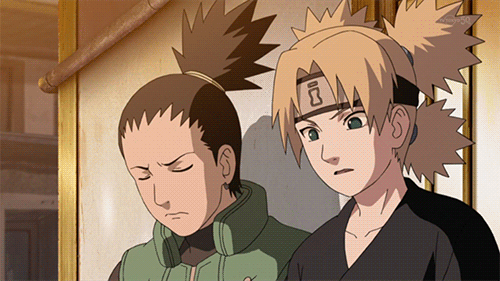

_________________________________
[2.) If you were asked, what flowers that remind you of Bakugou and Midoriya, what would they be?]
This is a really interesting question... While both the BNHA anime and manga are filled with symbolism, the series isn't particularly rich in hanakotoba symbolism compared to other series. Despite this, Katsuki and Izuku have been repeatedly depicted alongside cherry blossom trees, which perfectly encapsulate the growth and development of their dynamic across the series. I'm planning to cover this in an individual post where I can fully elaborate. So, for brevity's sake, I'll refrain from repeating things here. Since their dynamic is so nuanced, there are many other flowers that I think could suit them as well...


That being said, to the best of my knowledge, neither character has been individually associated with a canonical flower. So, if I were to pick one for each of them, I'd pick chamomile for Izuku and gloriosa for Katsuki. I tried to take both colour and meaning into consideration when selecting, though I'm sure there might be something better suited that I might not know about.

A) Izuku Midoriya: In Japan, chamomile flowers are called kamomīru (カモミール) and are associated with endurance and strength amidst adversity in hanakotoba. In Western floriography, they represent possessing patience and energy in adversity. The symbolism of the chamomile flower is primarily derived from its ability to persist when trampled on, as it continues to grow stronger as it is trodden on. The chamomile's symbolism greatly complements Izuku's enduring determination, empathy and resilience, which persist despite the challenges and obstacles he encounters.

B) Katsuki Bakugo: The gloriosa lily's name―which is derived from the Latin word “gloriosus” meaning splendid―was inspired by its bright, fiery colouration and majestic, wave-like petals. In Japan, gloriosa lilies are known as gurorioosa (グロリオサ). They are associated with glory and bravery in hanakotoba. In Western floriography, they symbolise passion, purity, beauty and pride. The gloriosa's association with glory, bravery and passion greatly complement Katsuki's determination for victory and drive to succeed―while its symbolism of pride is a reference to Katsuki's superiority complex. Gloriosa are also known as flame lilies or fire lilies, which serves as a nod to Katsuki's fire-based, explosion ability.
───────────────────────
#frostfire-asks#hanakotoba#anime hanakotoba#anime ships#shipping discourse#shipping discussion#bnha#mha#bakudeku#bkdk#naruto#naruto shippudden#minakushi#shikatema#katsudeku#dynadeku#izuku midoriya#katsuki bakugo
22 notes
·
View notes
Text
Put a finger down if you suddenly realised that the reason you've been subtly disliking one ship is the same reason you've been greatly enjoying another and as a result, you've come to the realisation that you were being hypocritical and now appreciate both ships.
Me: *Puts a finger down*
#ten points to whoever can figure out which two ships I'm referring to without looking at the rest of the tags#I was such a clown but at least I've matured a little...#anime shipping#shipping discourse#danmei#svsss#ren zha fanpai zijiu xitong#svsss mxtx#mxtx#scum villain's self saving system#knh#kusuriya no hitorigoto#the apothecary diaries#knh light novel
20 notes
·
View notes
Text
I know I might be biased because I prefer reading the light novels to watching the anime, but I really don’t like the way the anime handles some important scenes between Maoamo and Jinshi.
Because how can you go from this?

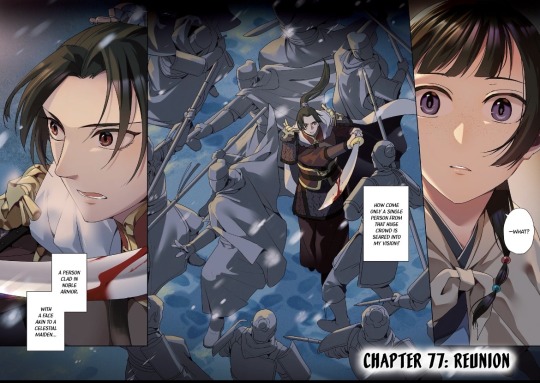
To this?!

Where’s the “she wasn’t sure how she knew, but she knew: she was sure she had seen him.”?!
Or her thinking that he migh be there to save her?!
The reunion scene was better, still not as impactful as in the books, but I can admit this is subjective.
Also, I don’t understand why they didn’t include this line when Maomao gave the hairpin to Loulan?

It’s wasn’t fine to not have it returned because she didn’t care that much. It was fine because she thought the hairpin might come back to her like its original owner does.
#my thoughts exactly...#after reading the ln my standards have been raised considerably#kusuriya no hitorigoto#the apothecary diaries#jinmao#jinshi#maomao#knh#knh season 2
799 notes
·
View notes
Text
What the—?!

Kusuriya no Hitorigoto Season 2
Official Art: Key Visual 4
Not them showing everyone in the next episode credits but high-ponytail, battle armor Jinshi:
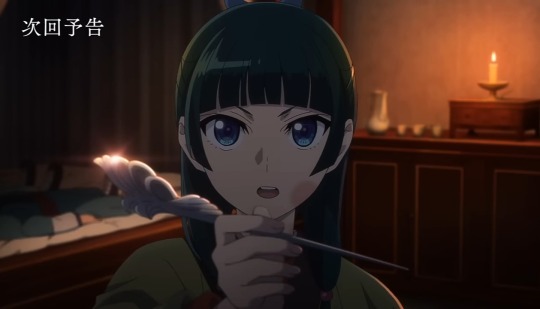

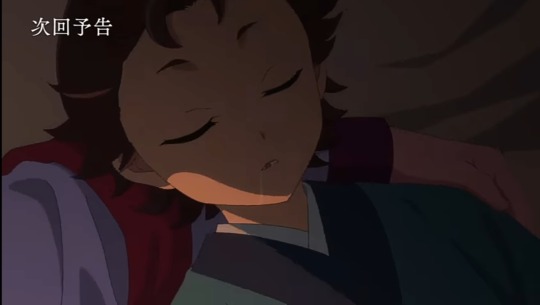






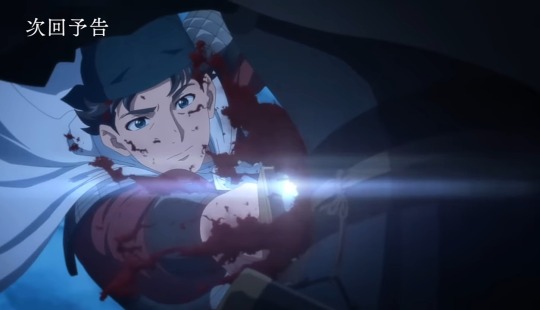
#speak of the devil!#Omg look at him!!! Maomao is so lucky!#kusuriya no hitorigoto#the apothecary diaries#knh#knh season 2#jinshi#jinshi knh
41 notes
·
View notes
Text
Not them showing everyone in the next episode credits but high-ponytail, battle armor Jinshi:










#They're not funny for teasing me like this#I meant to post this much earlier but got caught up🥲#kusuriya no hitorigoto#the apothecary diaries#jinshi#jinshi knh#knh#knh season 2
41 notes
·
View notes
Text


TGCF Donghua Official Birthday Artwork:
10/06 Hua Cheng
#P.S. I know I've been MIA for awhile now... my wifi was down... but I'm back now and will be working on getting asks and new posts out asap!#Anyways... I love this man sm...#Xie Lian is so blessed#hua cheng#san lang#tgcf#tian guan ci fu#heaven official's blessing#mxtx#mxtx tgcf#tgcf donghua#tgcf official art#crimson rain sought flower#hua chengzhu#hualian
283 notes
·
View notes
Text
I'm honestly dying to know what Suiren did to the ladies at the Jade Pavilion because both Maomao and Jinshi have brought it up in veiled terms...

“Really?" Hongniang said, sounding much less convinced than Gyokuyou. “You’re not thinking of Master Jinshi’s lady-in-waiting, are you?” (What had Suiren gotten up to in this pavilion?)
[V.4, C.6, P.53]
If she wanted a food taster, he was prepared to offer Suiren again. He imagined there was a good chance that the Jade Pavilion’s ladies would reject that idea, however. Hongniang herself had looked practically terrified.
[V.4, C.10, P.88]
#the energy she gives off is something else lmao#also I finally made it to volume 4!#suiren knh#kusuriya no hitorigoto#the apothecary diaries#knh season 2#knh light novel
43 notes
·
View notes
Text

TGCF Audio Drama Cover Art
S3EP11
#Omg! Finally some official art of Yushi Huang!!!! I swear she's too underrated!#p.s. is it just me who's confused that both the donghua and audio drama have decided to put her in blue robes?#since the book describes them as green and the manhua had her in green as well... or was that a mistranslation?#yushi huang#tgcf#tgcf audio drama#tgcf official art#tian guan ci fu#mxtx#mxtx tgcf
49 notes
·
View notes
Text
So who was going to tell me that ± 90% of the Kusuriya no Hitorigoto opening and ending songs are essentially Jinshi pining for Maomao?
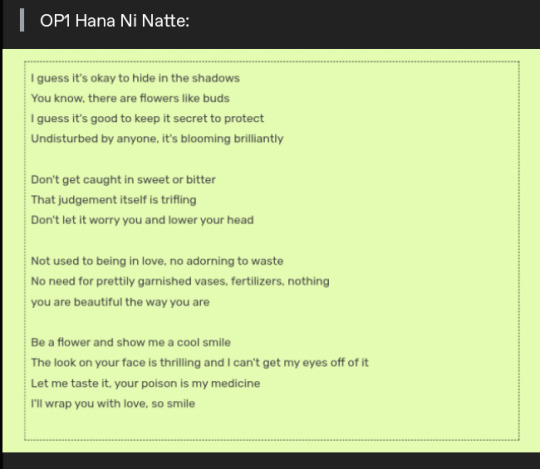
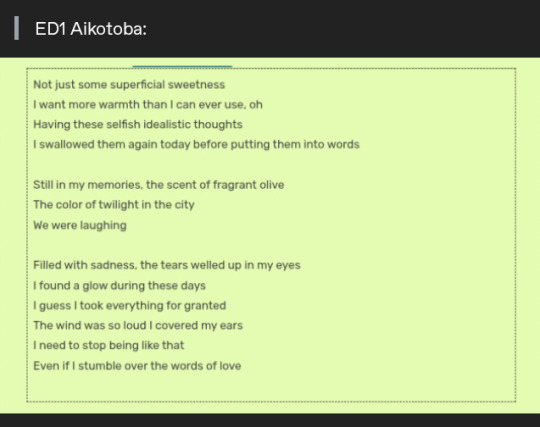

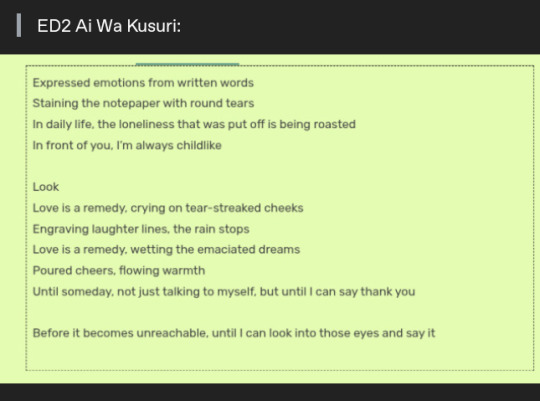
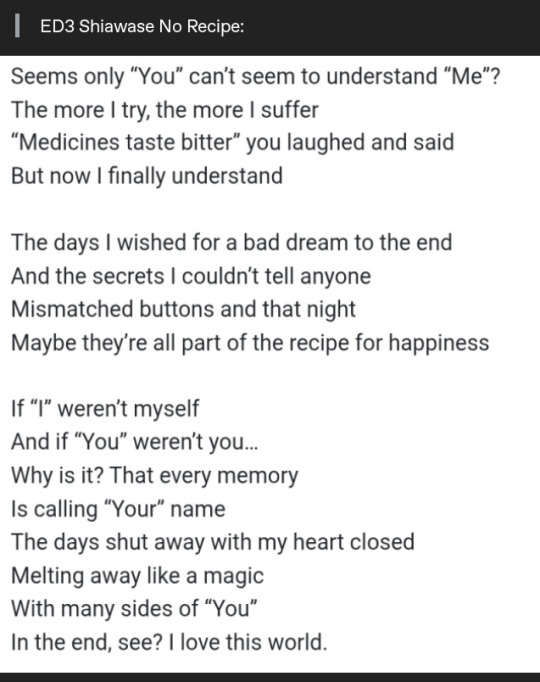
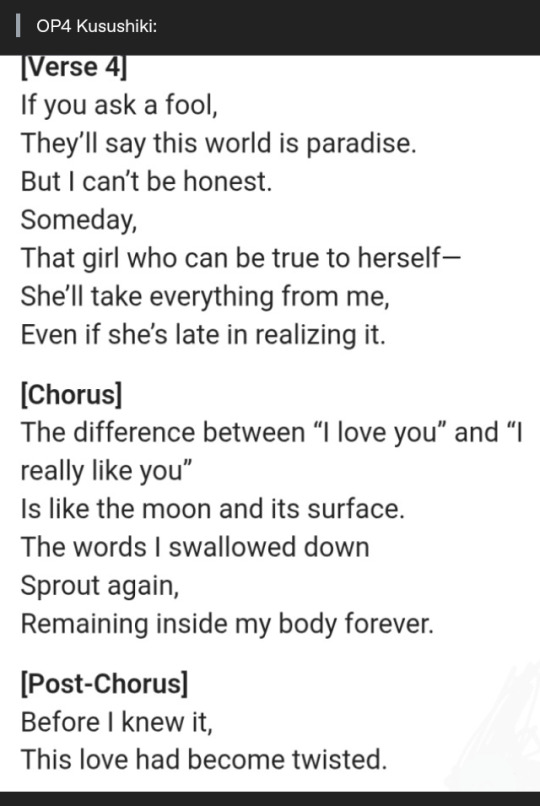
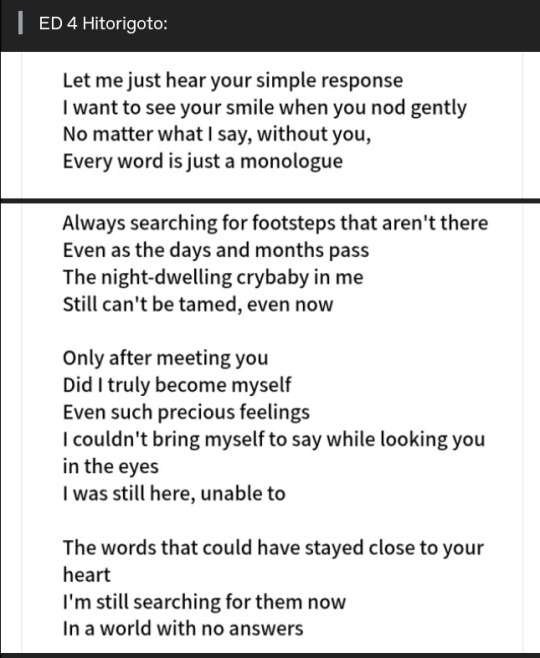
#it's embarrassing that it took me this long to notice given how often I listen to these songs#yes I know that knh doesn't revolve around just jinmao so naturally most of these songs do pertain to other characters and subplots as well#jinmao#jinshi x maomao#maomao x jinshi#the apothecary diaries#kusuriya no hitorigoto#knh#knh season 2#iI'm embarrassed an
100 notes
·
View notes
Text
My unadulterated reaction to the results of the 2025 Crunchyroll Anime Awards:




[P.S. Like wdym neither The Apothecary Diaries nor Frieren won aoty?! Wdym The Apothecary Diaries only won 1 award?! Wydm not a single shoujo anime won any award because only 1 was nominated?!]
#the apothecary diaries and frieren were robbed...#disappointed but not surprised#crunchyroll anime awards#Crunchyroll anime awards 2025#sousou no frieren#frieren: beyond journey's end#kusuriya no hitorigoto#the apothecary diaries#anime awards
57 notes
·
View notes
Text

TGCF Audio Drama Cover Art
S3EP08
#I don't usually post the artwork of the audio drama even though it's my favourite tgcf artstyle but guys!!!!#The sun × moon elements in their designs are chef's kiss#Is this not the first official coloured artwork of QuanYin?!#look at them aaaaahhhhh!!!!#quanyin#tgcf#tian guan ci fu#heaven official's blessing#mxtx#mxtx tgcf#tgcf audio drama#quan yizhen x yin yu#yin yu x quan yizhen#quan yizhen#qi ying#yin yu
96 notes
·
View notes
Note
As fan of animated series, have you watched either Voltron : Legendary Defender or Avatar : Legend of Aang? What are your fav ships from those series?
Mine are Klance (Keith/Lance) and Zutara (Zuko/Katara). Can I ask your thoughts on them?
Sorry if you're a fan of Kataang (Katara/Aang) or Maiko (Mai/Zuko) or Shiro/Keith or Lance/Allura.
Oh yeah because you've finished Thousand Autumbs, here is my all time fav YanShen fic : "The Double-Headed Dragon" by BastetCG
https://archiveofourown.org/works/38819133/chapters/97068426
(Hope you'll like them)
Hey, thanks for sending in an ask! Admittedly, I haven't watched many animated series that aren't anime because, as I was growing up, I was limited to what aired on TV since my family didn't have any streaming services or Wi-Fi. Even with anime, for a long time I couldn't actively choose what I wanted to watch since I could only get downloaded episodes from friends or watch what aired on TV—namely the big four..
That being said, I haven't seen Voltron but I have seen Avatar: The Last Airbender. It was a decent series—and I liked many aspects about it—but I don't have the same attachment to it as most people do because I watched it as an adult. The worldbuilding and power system were probably my favourite aspects of the series.

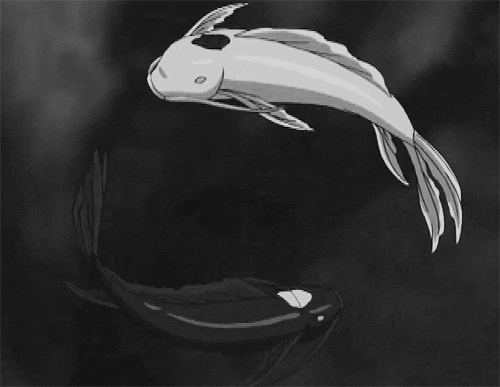
As for ships, I didn't have many that I liked since I felt like the series was always more focused on platonic bonds—but Zuko × Katara and Sokka × Suki are my favourites from the series. I feel like some of the pairings in my top 30 ships list have somewhat similar dynamics, so hopefully my choices don't surprise anyone haha...
I was honestly really shocked that Zutara wasn't canon... All the content I saw of them before watching the series, as well as how complex their dynamic was, really had me thinking they would end up together... They had so much chemistry and potential that just thinking about it all again gets me riled up.
My favourite aspect of Zuko and Katara's dynamic was that although they contrasted each other in many ways, on a fundamental level, they had many similarities. This gave them an inherent and sincere chemistry that didn't feel forced lending their dynamic a sense of emotional depth and richness.
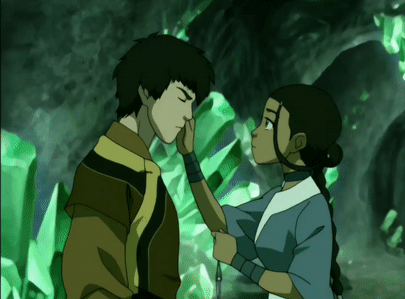
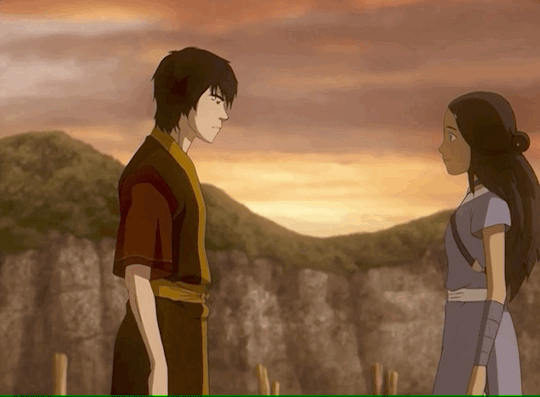
I'm sorry that I can't comment on Voltron or Klance considering I haven't watched that series and probably never will since mecha is one of the few genres I don't have interest in...
Thanks for the Thousand Autumns fic rec! I really miss the series even though I finished it not that long ago... I wish the donghua had a nicer art style but maybe I'm just too picky... A manhua adaptation would be cool too...
P.S. Sorry it took me so long to respond... Things have been a bit stressful lately...
15 notes
·
View notes
Text
One of my goals in life is to find someone who pines for me as much as Jinshi pines for Maomao when she's not around...
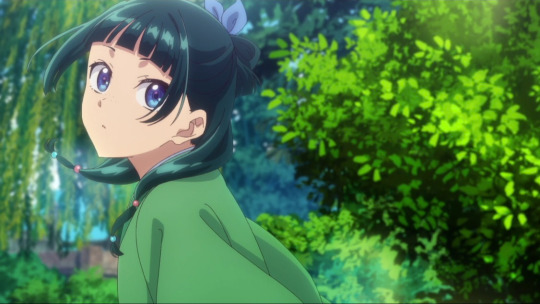
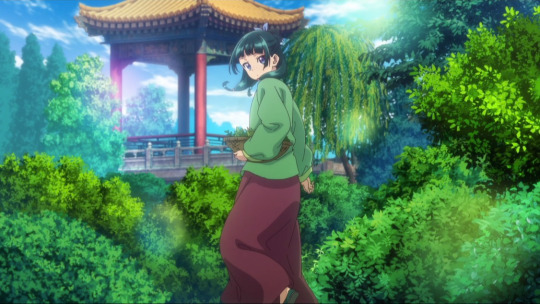
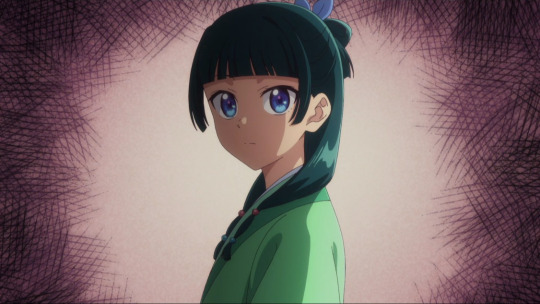
#she lives in his head rent free#notice that when he reminisces about her here she's not “dolled up” but is instead in her element... I love them sm!#I can't believe it's taken me this long to make a post about last week's episode...#Like I watched it a while ago and loved it but wasn't sure what to say exactly—but I want to post something about Jinshi later this week...#the apothecary diaries#kusuriya no hitorigoto#knh season 2#jinmao#jinshi x maomao#maomao x jinshi
218 notes
·
View notes